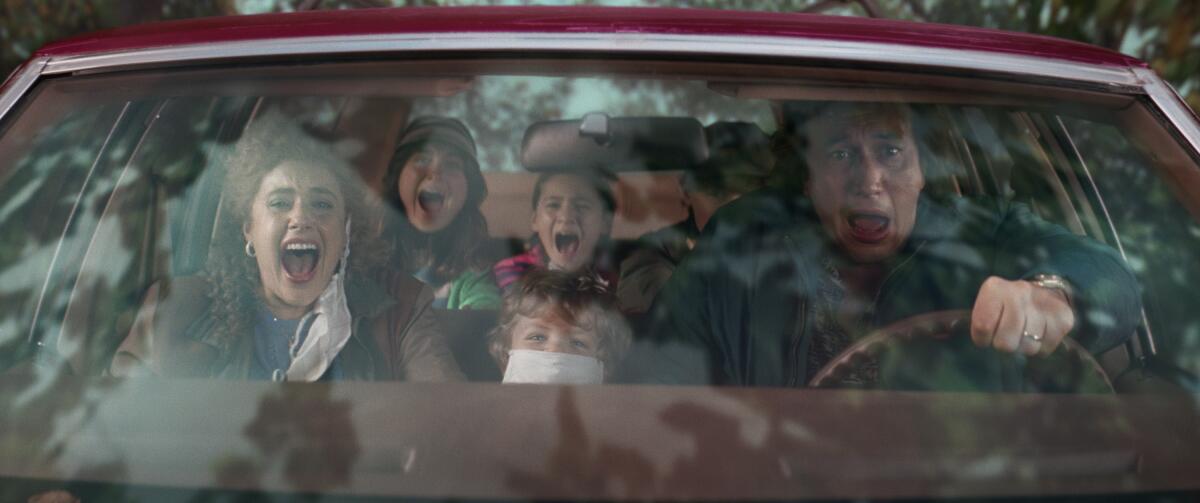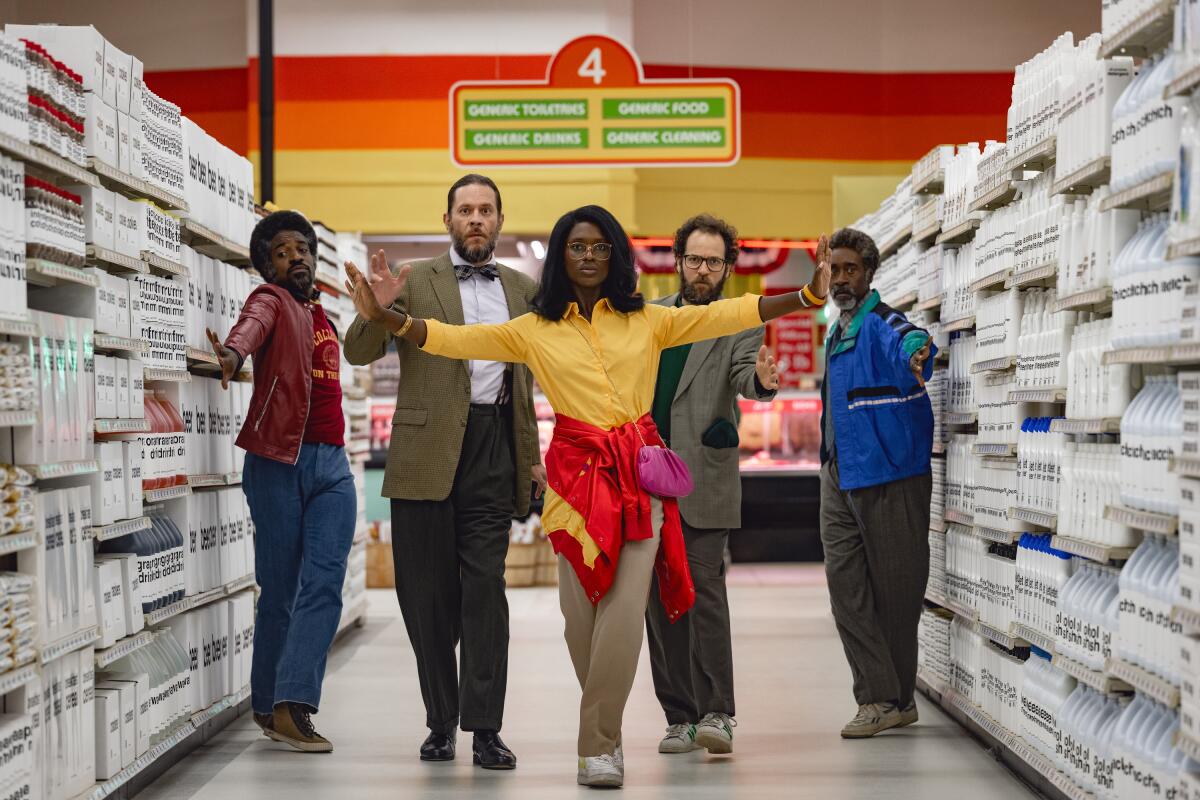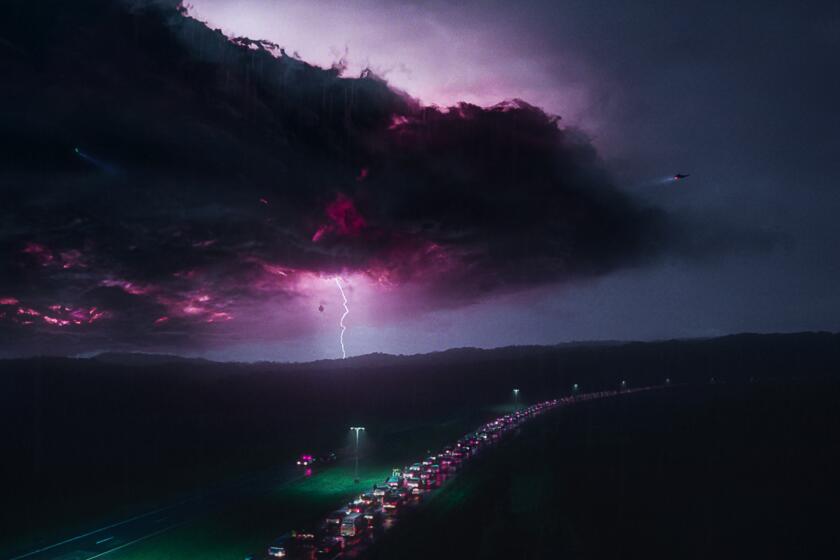How Noah Baumbach and Matthew Hannam found the rhythms -- and action -- of ‘White Noise’

Surprisingly enough, given the reputation Don DeLillo’s novel “White Noise” has as being unfilmable, writer-director Noah Baumbach’s adaptation is marked by its fidelity to the source text. Though you won’t see “the world’s most photographed barn,” perhaps the most famous fictional artifact of DeLillo’s 1985 postmodern masterwork, you’ll hear much of DeLillo’s clipped, coolly sophisticated dialogue spoken aloud.
Where Baumbach’s film takes greatest liberties is on the level of tone. When the director and editor Matthew Hannam gathered in New York, London and Los Angeles to edit the film, they brought their own spin to the novel’s existential toggle between signal and noise.
Speaking via Zoom, Baumbach says that in several scenes, including those set inside the busy home of protagonists Jack and Babette Gladney, they created a cacophony of sound through overlapping dialogue.
“We miked everybody, and everybody was on separate tracks,” Baumbach says. “It did create editorial challenges, because the cacophony from take to take is never exactly the same.”
Hannam adds that “those scenes were reverse-engineered, because we wanted to make the sound drive the energy of the scene. You couldn’t necessarily figure that out with the picture, because everyone’s moving all over the place. It was really an exercise in us finding the rhythms in the actors’ performances and figuring out to what degree we can overlap and complicate the sound and then make the picture match it.”
Baumbach’s films, which include “The Squid and the Whale” and “Frances Ha,” are generally talky and intimate, whereas the bigger-budget “White Noise” includes car chases and an “airborne toxic event.” For the filmmaker, however, the various projects share a conceptual unity.
One of the many challenges Noah Baumbach faced adapting Don DeLillo’s 1985 novel was creating the ‘airborne toxic event’ at the story’s heart.
“In my previous movies,” Baumbach says, “which are original scripts, I’ve always been drawn to characters who don’t always mean exactly what they’re saying, and dialogue that’s a form of communication but also obfuscation. That’s all obviously a part of DeLillo’s story as well.”
The filmmakers framed “White Noise” within a clear three-act structure, plus an epilogue dance sequence. To underscore this, they show DeLillo’s three chapter headings as on-screen titles.
Hannam says, “There’s a certain friction that you can create with a chapter heading. There’s really three parts to it: There’s the outgoing image, there’s the title, and there’s the incoming image. For us in the editing room, it was a real pleasure to come up with the energy going in [to the title image] and then stop it entirely. And then what comes next is a product of those two things. My favorite example is when we show “The Airborne Toxic Event” over the image of a pristine neighborhood. Like, ‘These idiots don’t know what’s coming.’”
Baumbach says he wanted to make the three-act structure explicit because “I’m always interested in movies where, because of either narrative or emotional or structural developments, other things suddenly become available to you. In Part 1, the camera really only moves with the characters. It’s this illusion we create that we are in control of our lives, and the camera goes with us. In Part 2, the camera starts to move without them, and in Part 3, the camera really starts to move beyond the characters. Sound starts to break down and become even more ambient, more musical, less literal. Matt and I always saw the dance sequence as just a further development of that.”

Indeed, the movie is choreographed throughout — from the controlled chaos of the Gladney family in the kitchen, to a sequence where two professors offer dueling lectures on Elvis and Hitler, to the musical grace of the station wagons making their way up to the College-on-the-Hill.
For the filmmakers, the most complicated sequences were the big action scenes. Baumbach says the biggest challenge “is that we did everything practically. We really put the car in the creek, and they’re really running from the Boy Scout camp, and things are falling around them. The challenge is to do things safely, but with real dynamism.”
Like Baumbach, Hannam was also new to action sequences, and he saw his freshness as a benefit. “The thing I learned on this project,” he says, “is that with a lot of that stuff, you’re better off not knowing how to do it by heart. Like, ‘let’s do a No. 6 on this one, Charlie.’ Instead, it’s fun to just say, ‘imagine if the camera could go here.’”
“It was a joy,” Hannam adds. “In the script, it says, ‘Jack starts to drive the car like a boat.’ It’s pretty fun editorially to figure out how to make it feel that way.”
For the film’s climactic supermarket dance sequence, set to a new LCD Soundsystem song, Baumbach wanted to create the sense that “the movie kind of breaks open in the end.”
Hannam says that the sequence is crucial to the filmmakers’ overall vision. “Noah and I always, always talked about how the other version of this movie is a dour criticism, and we always wanted to be celebratory. As soon as you accept death and stop trying to take a pill to make the fear go away, you can dance a little bit.”
More to Read
From the Oscars to the Emmys.
Get the Envelope newsletter for exclusive awards season coverage, behind-the-scenes stories from the Envelope podcast and columnist Glenn Whipp’s must-read analysis.
You may occasionally receive promotional content from the Los Angeles Times.











